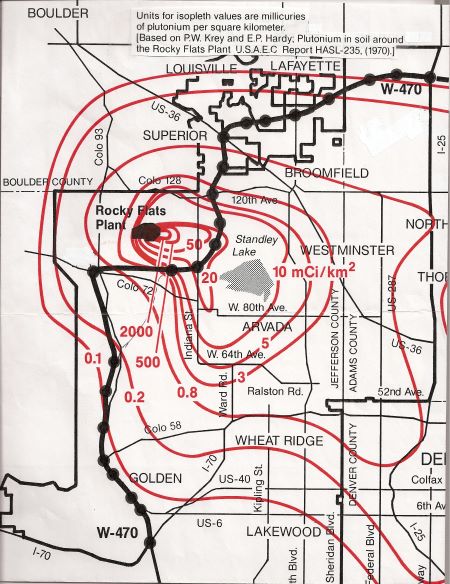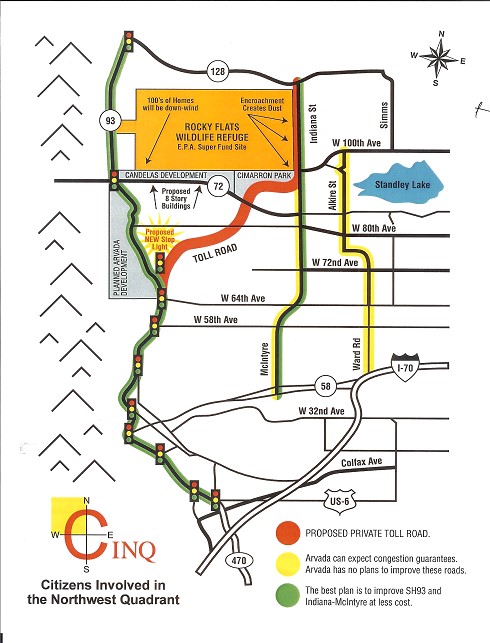On November 17 the Jefferson County Commissioners passed a resolution (reproduced below) offering to pay $5 million to the State Land Board to purchase Section 16 at the southwest corner of the Rocky Flats Wildlife Refuge, if the City of Boulder and Boulder County also pay $2 million each and drop their opposition to the proposed Jefferson Parkway, City of Boulder Mayor and forum panelist Susan Osborne disclosed at a PLAN-Boulder forum on November 19. Section 16 is a 640-acre parcel bordering the east side of Highway 93 which preservationists covet in order to prevent commercial and residential development from spreading north and to create a corridor for wildlife to migrate between the Refuge and the foothills to the west. The State Land Board is asking $10 million for Section 16, Osborne said; and under the Jefferson County Commissioners’ offer another $1 million would have to be raised from other sources. If Section 16 is acquired, Boulder officials expect that it would ultimately be incorporated into the Refuge, Osborne indicated.
The Jefferson County Commissioners’ offer expires on December 31. Boulder City Council member Lisa Morzel, who attended the PLAN-Boulder forum, said that the Boulder City Council will consider it at its December 7 and December 21 meetings. Neither Osborne nor Morzel would predict whether the Boulder City Council will accept the offer.
The route of the Jefferson Parkway, a toll road, is planned to run through a 300-foot wide strip on the eastern boundary of the Refuge. The 2001 federal statute creating the Refuge explicitly allows a parkway in that part of the property, another forum panelist, Broomfield Mayor Pat Quinn, declared. However, Morzel observed that the Refuge Act requires that the impact of a parkway on the Refuge be “minimal.” She contended the development that would be enabled by the Parkway is much more intense than had been contemplated in 2001 and arguably would have more than “minimal” impact.
Forum panelist Bob Yuhnke, Transportation Program Director for the Southwest Energy Efficiency Project (SWEEP), also noted that a 2005 federal law requires an analysis of the effects of the Parkway on the Refuge. Although an Environmental Impact Statement was done many years ago by the Interior Department, according to Yuhnke it was limited largely to the likely effects of the Parkway on wildlife. Yuhnke asserted that that analysis was probably legally inadequate, since it did not cover other critical elements, such as the likely impact of the Parkway on vehicle miles traveled (VMT) in the metro area and the possible dispersal of radioactive material from parkway construction activity.
LeRoy Moore, a member of the audience who is a consultant for the Rocky Mountain Peace and Justice Center, said that plutonium has been found recently under a home a mile east of the Refuge. Jane Monson, another audience member, shared a copy of a map made in 1989 for a successful campaign against W-470 (which, she related, lost by a margin of four to one) showing plutonium contamination around the Refuge. Quinn remarked that Broomfield City Manager George Di Ciero has long maintained that the United States Department of Energy “did not clean the site. It contained the site.”
Yunke revealed that the Sierra Club has prepared a lawsuit challenging the Jefferson Parkway on the basis of the 2005 federal law. But he cautioned that the lawsuit could not be filed until such time as the United State Interior Department grants a right-of-way through the Refuge for the Parkway. The recent offer of the Jefferson County Commissioners would prohibit the City of Boulder and Boulder County from joining in that lawsuit, or initiating their own.
Forum panelist Tom Hoffman, the manager of Citizens Involved in the Northwest Quadrant (CINQ), noted that highways have traditionally been considered critical to stimulating new commercial development. The Jefferson Parkway would serve the massive Candelas residential and commercial development, as well as Cimarron Park, that would abut the southern boundary of the Refuge. Morzel remarked that another large development is expected south of Candelas at Leyden Gulch.
Hoffman asserted that the Jefferson Parkway will need a private partner to provide money for construction and initial operation. He said that the Parkway would channel additional traffic into the south end of Highway 93. According to Hoffman, Jefferson County officials had historically maintained that tolls from Jefferson Parkway, rather than tax revenue, would pay for improvements to Highway 93.
However, the fifth panelist at the forum, Dick Sugg, who has written a comprehensive article in the Blue Line about the background of Jefferson Parkway, observed that at present there is no plan to widen or otherwise improve Highway 93. Sugg also noted that the Parkway is not now expected to pass through Interlocken and connect with the Northwest Parkway. Sugg recounted that one study conducted by the Parkway Authority concerning air pollution impacts showed a relatively low traffic volume on the Parkway, while another study concerning the financial viability of the Parkway showed a different and much higher traffic volume.
Yuhnke said that SWEEP has calculated that the Jefferson Parkway would increase VMT by 17 percent over that which would occur if it were not built. He explained that SWEEP is trying to persuade urban planners to orient new development in the Denver Metro Area around FasTracks stations. He claimed that VMT would be reduced by one percent in Arvada if new development were clustered around FasTracks stations, rather than being located as presently projected. According to Yuhnke, SWEEP’s proposal would not reduce the total amount of new development intended by Arvada.
The text of the Jeffco resolution:
BEFORE THE BOARD OF COUNTY COMMISSIONERS
OF THE COUNTY OF JEFFERSON
STATE OF COLORADO
RESOLUTION NO. CC10-448
RE: BOARD OF COUNTY COMMISSIONERS – REGIONAL VISION OF THE NORTHWEST QUADRANT OF JEFFERSON COUNTY
WHEREAS, interested parties desire to achieve an overall regional vision in the northwest quadrant of Jefferson County to balance the competing interests of construction of a major transportation corridor known as the Jefferson Parkway, preservation of regional open space and wildlife habitat, and creation of economic development opportunities, and
WHEREAS, the interested parties arrived at principles and an implementation strategy to implement this regional vision, and
WHEREAS, while the parties recognize there are numerous details related to property acquisition described herein, and as such the accompanying negotiations may take an extended period of time, the parties approve this plan of action in good faith, in the spirit of cooperation and a commitment to achieve the regional vision discussed above.
NOW THEREFORE, BE IT RESOLVED, that the Board of County Commissioners supports implementation of the regional vision as follows:
1. Jefferson County, the City of Boulder, and the County of Boulder agree that they will support the acquisition and transfer of land along the eastern edge of the Rocky Flats Wildlife Refuge, known as the transportation right-of-way denoted in Section 3174 of the Rocky Flats Wildlife Refuge Act of 2001, from the U.S. Fish & Wildlife Service (USF&WS) to the Jefferson Parkway Public Highway Authority (JPPHA) for the express use as a multi-model transportation corridor.
2. Jefferson County, the City of Boulder and the County of Boulder recognize and agree that the acquisition of the transportation right-of-way by the JPPHA shall be accomplished by a separate transaction and shall not be contingent upon, or delayed until, the conclusion of any property acquisition transaction related to any portion of Rocky Flats Section 16.
3. Jefferson County, the City of Boulder, and the County of Boulder agree that they support, and will work collaboratively with the Colorado State Board of Land Commissioners (State Land Board) to acquire property interests that achieve the permanent preservation of Rocky Flats Section 16 as publicly owned open space and/or wildlife refuge. Any other jurisdictions, agencies or entities may participate in the contribution of funding or resources necessary to acquire property interests in Rocky Flats Section 16 as long as any contribution of funding or resources has no condition counter to the principles outlined herein.
4. Jefferson County hereby commits $5,000,000 to acquire property interests in Rocky Flats Section 16 from the State Land Board. This commitment by Jefferson County will expire by January 1, 2011 if the City of Boulder and the County of Boulder have not agreed to the principles outlined herein. Further, if the parties agree to the principles outlined herein by January 1, 2011, Jefferson County will maintain its $5,000,000 commitment until January 1, 2016.
5. Jefferson County, the City of Boulder and the County of Boulder will also work to acquire the mineral leases on Rocky Flats Section 16, and will support efforts to transfer the underlying mineral rights from the State Land Board to the USF&WS.
6. The City of Boulder and the County of Boulder agree that they will adopt a neutral position on construction of the Jefferson Parkway and will not oppose the transfer of right of way from the USF&WS, or seek to overturn the existing approval by the Denver Regional Council of Governments (DRCOG), or support any legal actions attempting to block the construction of the Jefferson Parkway.
The Resolution was adopted by unanimous vote of the Board of County Commissioners of the County of Jefferson, State of Colorado.
Dated: November 23, 2010





